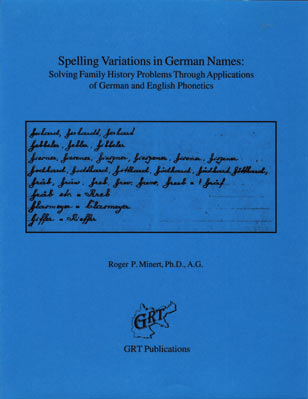 Changes in the spelling of surnames when immigrants came to America create problems enough for genealogists. Add to this name changes made afterwards, often to better fit the local culture or simplify a names usage. Now add these issue to surnames and locations in foreign countries with changes in spelling over time. In research, questions like, “How can Diependörper and Tiefendorfer be the same name?” are often as common as most researchers are unprepared to deal with them. Surprising to many, these changes are “natural, logical, and predictable,” not to mention, explicable. Spelling Variations in German Names: Solving Family History Problems Through Applications of German and English Phonetics is a thorough study of German name changes and the means to understand these changes.
Changes in the spelling of surnames when immigrants came to America create problems enough for genealogists. Add to this name changes made afterwards, often to better fit the local culture or simplify a names usage. Now add these issue to surnames and locations in foreign countries with changes in spelling over time. In research, questions like, “How can Diependörper and Tiefendorfer be the same name?” are often as common as most researchers are unprepared to deal with them. Surprising to many, these changes are “natural, logical, and predictable,” not to mention, explicable. Spelling Variations in German Names: Solving Family History Problems Through Applications of German and English Phonetics is a thorough study of German name changes and the means to understand these changes.
Throughout the pages of this guide, author Roger P. Minert, PhD, A.G., helps the reader uncover patterns in the variation of vowels and consonants. For example, how -bach and -beck are of the same origin. Likewise, -trup and -dorf have the same meaning. Minert reveals underlying phonetic principles, which through learning and understanding, help the researcher uncover the patterns necessary to follow spelling changes.
The book serves genealogist at all skill levels. Even experts are often unaware of how the science of phonetics plays into the pattern of name changes. This science deals with “the sound of speech, their production, description, and representation in written symbols.” This guide provides basic technical understanding researchers can use to compare variant spellings and to more easily identify possible variation; like, with Diependörper and Tiefendorfer, which might otherwise be overlooked.
Table of Contents
Introduction
List of Tables, Illustrations, and Maps
1.0 History
2.0Symbols and Notations
3.0Vowels: Introduction
3.1 Length of vowels
3.2 Location of vowels in the mouth
3.3 Unrounded vowels
3.4 Rounded vowels
3.5 Doubled vowels
3.6 Diphthongs
3.7 The character ie
3.8 Silent vowels
3.9 Unaccented neutral vowel
3.10 Search/research tactics with vowels in Germany
3.11 Search/research with vowels between Germany and America
4.0 Consonants: Introduction
4.1 Points of articulation
4.2 Types of articulation
4.3 More important terms describing consonants
4.4 Specific consonant sounds
4.5 Doubled consonants
4.6 Search/research tactics with consonants in Germany
4.7 Search/research tactics with consonants between Germany and America
5.0 Elision of e and i
5.1 Elision of e and i in unstressed syllables
5.2 Elision of e in the diphthong environment
6.0 Non-Phonetic Variations
6.1 The suffix -in
6.2 Possessive markers
6.3 Latin declinations
6.4 Errors in deciphering and extracting names
6.5 Names translated entirely or partially
7.0 The Old High German Sound Shift
7.1 The role of the Old High German Sound Shift in German genealogical research: Introduction
7.2 The theory of the Old High German Sound Shift
7.3 Practical application of the OHGSS in genealogical research
7.4 Summary
8.0 Conclusions
9.0 Trouble-Shooting Guide to Name Spelling Variations: Introduction
Notes Annotated Bibliography
Glossary
Table 12: Trouble-shooting Guide
Every Name Index
Spelling Variations in German Names: Solving Family History Problems Through Applications of German and English Phonetics is available from Family Roots Publishing; Price: $16.12.
I have found my knowledge of the Cyrillic alphabet used in Russian and other eastern European languages helpful in understanding how German names can be “misspelled” by people whose primary language is English.
My favorite example is the 18th century Russian playwright Denis Fonvizin. I find it a bit flabbergasting that as it is well-known that he was of German ancestry, his grandfather as I recall being an artisan recruited by Peter the Great on the latter’s Grand Tour of Europe, that the original spelling, von Wiesen(?), is not used when the lettering of the surname is converted back to our Latin alphabet!